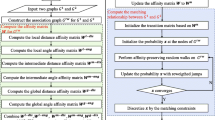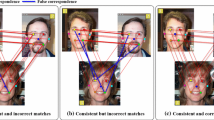Abstract
Graph matching is an essential NP-problem in computer vision and pattern recognition. In this paper, we propose an approximate graph matching method. This method formulates the problem of computing the correspondences between two graphs as a problem of selecting nodes on an association graph. The nodes of the association graph represent candidate correspondences between the two original graphs. Our method first constructs an affinity matrix based on both the global and local information of the original graphs’ nodes. Each element of this matrix is used to measure the mutual consistency of a pair of nodes within the association graph. Our method then applies the reweighted random walks technique that preserves the one-to-one matching constraint to simulate random walks on the association graph and to iteratively compute a quasi-stationary distribution. To discretize this distribution, our method finally applies the Hungarian algorithm and obtains an approximate matching between the original two graphs. Experimental results demonstrate the effectiveness of our method for graph matching and the ability of our method for being robust to outlier and deformation noise.














Similar content being viewed by others
Notes
We did not show the experiments about the edge density because the experiment about the edge density cannot obtain the information of the nodes (x-y node coordinates) when computing the affinity matrix.
For each frame pair, we randomly selected ns points of the first image by 10 times to generate 10 graph pairs. We used the average matching accuracy of these 10 pairs to represent the matching accuracy corresponding to this frame pair.
References
Albarelli A, Bulo SR, Torsello A, Pelillo M (2009) Matching as a non-cooperative game. In: IEEE conference on computer vision, pp 1319–1326
Berg AC, Berg TL, Malik J (2005) Shape matching and object recognition using low distortion correspondences. In: IEEE Conference on computer vision and pattern recognition, vol 1, pp 26–33
Carletti V, Foggia P, Greco A, Vento M, Vigilante V (2019) VF3-Light: a lightweight subgraph isomorphism algorithm and its experimental evaluation. Pattern Recognit Lett 125:591–596
Chen HT, Lin HH, Liu TL (2001) Multi-object tracking using dynamical graph matching. In: IEEE Conference on computer vision and pattern recognition, vol 2, pp 210–217
Cho M, Lee J, Lee KM (2010) Reweighted random walks for graph matching. In: European conference on computer vision. Springer, pp 492–505
Cho M, Sun J, Duchenne O, Ponce J (2014) Finding matches in a haystack: a max-pooling strategy for graph matching in the presence of outliers. In: IEEE Conference on computer vision and pattern recognition, pp 2083–2090
Cordella LP, Foggia P, Sansone C, Vento M (2004) A (sub)graph isomorphism algorithm for matching large graphs. IEEE Trans Pattern Anal Mach Intell 26(10):1367–1372
Cour T, Shi J (2007) Solving Markov random fields with spectral relaxation. In: Artificial intelligence and statistics, pp 75–82
Cour T, Srinivasan P, Shi J (2007) Balanced graph matching. In: Conference on advances in neural information processing systems, pp 313–320
Duchenne O, Joulin A, Ponce J (2011) A graph-matching kernel for object categorization. In: International conference on computer vision. IEEE, pp 1792–1799
Foggia P, Percannella G, Vento M (2014) Graph matching and learning in pattern recognition in the last 10 year. Int J Pattern Recognit Artifici Intelligenc 28 (1):1–40
Gold S, Rangarajan A (1996) A graduated assignment algorithm for graph matching. IEEE Trans Pattern Anal Mach Intell 18(4):377–388
Gori M, Maggini M, Sarti L (2004) Graph matching using random walks. In: International conference on pattern recognition, vol 3, pp 394–397
Gori M, Maggini M, Sarti L (2005) The RW2 algorithm for exact graph matching. Lect Notes Comput Sci 3686:81–88
Haveliwala TH (2002) Topic-sensitive pagerank. In: ACM International conference on World Wide Web, pp 517–526
Hu YT, Lin YY (2016) Progressive feature matching with alternate descriptor selection and correspondence enrichment. In: IEEE Conference on computer vision and pattern recognition, pp 346–354
Hu N, Rustamov RM, Guibas L (2014) Stable and informative spectral signatures for graph matching. In: IEEE Conference on computer vision and pattern recognition, pp 2305–2312
Jiang B, Zhao H, Tang J, Luo B (2014) A sparse nonnegative matrix factorization technique for graph matching problems. Pattern Recognit 47(2):736–747
Jiang B, Tang J, Ding C, Luo B (2015) A local sparse model for matching problem. In: Twenty-ninth AAAI conference on artificial intelligence, pp 3790–3796
Jiang B, Tang J, Cao X, Luo B (2017) Lagrangian relaxation graph matching. Pattern Recognit 61:255–265
Jiang B, Tang J, Ding CH, Luo B (2017) Nonnegative orthogonal graph matching. In: Association for the advance of artificial intelligence, pp 4089–4095
Jiang B, Tang J, Luo B (2019) Efficient Feature Matching via Nonnegative Orthogonal Relaxation. Int J Comput Vis 127(9):1345–1360
Khue Le-Huu D, Paragios N (2017) Alternating direction graph matching. In: IEEE Conference on computer vision and pattern recognition, pp 6253–6261
Lawler EL (1963) The quadratic assignment problem. Manag Sci 9(4):586–599
Leordeanu M, Hebert M (2005) A spectral technique for correspondence problems using pairwise constraints. In: IEEE International conference on computer vision, vol 2, pp 1482–1489
Leordeanu M, Hebert M, Sukthankar R (2009) An integer projected fixed point method for graph matching and map inference. In: International conference on neural information processing systems, pp 1114–1122
Liu ZY, Qiao H (2014) GNCCP-graduated nonconvexity and concavity procedure. IEEE Trans Pattern Anal Mach Intell 36(6):1258–1267
Liu M, Wang L, Nie L, Dai J, Ji D (2016) Event graph based contradiction recognition from big data collection. Neurocomputing 181:64–75
Liu M, Wei Y, Qian W, Zhang H (2017) Robust plant cell tracking in noisy image sequences using optimal crf graph matching. IEEE Signal Proc Lett 24(8):1168–1172
Liu X, Li F, Na Z (2017) Optimal resource allocation in simultaneous cooperative spectrum sensing and energy harvesting for multichannel cognitive radio. IEEE Access 5:3801–3812
Liu X, Jia M, Na Z, Lu W, Li F (2018) Multi-modal cooperative spectrum sensing based on Dempster-Shafer fusion in 5g-based cognitive radio. IEEE Access 6(99):199–208
Liu ZY, Qiao H, Yang X, Hoi SC (2014) Graph matching by simplified convex-concave relaxation procedure. Int J Comput Vis 109(3):169–186
Mills-Tettey GA, Stentz A, Dias MB (2007) The dynamic hungarian algorithm for the assignment problem with changing costs. Carnegie Mellon University
Nie W, Ding H, Liu A, Deng Z, Su Y (2018) Subgraph learning for graph matching. Pattern Recognit Lett, in press
Nie WZ, Liu AA, Gao Y, Su YT (2018) Hyper-clique graph matching and applications. Trans on Circuit and Syst for Video Technol 99:1–12
Riesen K, Jiang X, Bunke H (2010) Exact and inexact graph matching: methodology and applications. Manag Min Graph Data, 217–247
Sahni S, Gonzalez T (1976) P-complete approximation problems. J ACM 23 (3):555–565
Solnon C (2010) Alldifferent-based filtering for subgraph isomorphism. Artif Intell 174:850–864
Ullmann JR (1976) An algorithm for subgraph isomorphism. J ACM 23(1):31–42
Ullmann JR (2010) Bit-vector algorithms for binary constraint satisfaction and subgraph isomorphism. J Exp Algorithmics (JEA) 15:1–6
Wang T, Ling H, Lang C, Feng S (2018) Graph matching with adaptive and branching path following. IEEE Trans Pattern Anal Mach Intell 40(12):2853–2867
Wu J, Shen H, Li YD, Xiao ZB, Lu MY, Wang CL (2013) Learning a hybrid similarity measure for image retrieval. Pattern Recognit 46(11):2927–2939
Wu Y, Gong M, Ma W, Wang S (2019) High-order graph matching based on ant colony optimization. Neurocomputing 328:97–104
Yang X, Qiao H, Liu ZY (2015) Outlier robust point correspondence based on gnccp. Pattern Recognit Lett 55:8–14
Yan J, Yin XC, Lin W, Deng C, Zha H, Yang X (2016) A short survey of recent advances in graph matching. In: ACM International conference on multimedia retrieval, pp 167–174
Yu T, Yan J, Wang Y, Liu W (2018) Generalizing graph matching beyond quadratic assignment model. In: Advances in neural information processing systems, pp 853–863
Zhang J, Ma S, Sclaroff S (2014) Meem: robust tracking via multiple experts using entropy minimization. In: European conference on computer vision. Springer, pp 188–203
Zhang Z, Shi Q, McAuley J, Wei W, Zhang Y, Van Den Hengel A (2016) Pairwise matching through max-weight bipartite belief propagation. In: IEEE Conference on computer vision and pattern recognition, pp 1202–1210
Zhang L, Liu M, Chen L, Qiu L, Zhang C, Hu Y, Zimmermann R (2017) Online modeling of esthetic communities using deep perception graph analytics. IEEE Trans Multimed 20(6):1462–1474
Zhou F, Torre FDL (2012) Factorized graph matching. In: IEEE Conference on computer vision and pattern recognition, pp 127–134
Acknowledgements
This research was supported by Natural Science Foundation of Shandong province (No. ZR2019BF026, ZR2019MF013, ZR2017BF031), Project of Jinan Scientific Research Leader’s Laboratory (No. 2018GXRC023) and Doctoral Program of University of Jinan (No. 160100313). In addition, we thank Prof. Caiming Zhang for putting forward some good ideas and suggestions when revising the manuscript.
Author information
Authors and Affiliations
Corresponding author
Additional information
Publisher’s note
Springer Nature remains neutral with regard to jurisdictional claims in published maps and institutional affiliations.
Yaru Zhan and Xiuyang Zhao contributed equally to this work and should be considered co-first authors.
Rights and permissions
About this article
Cite this article
Zhan, Y., Zhao, X., Lin, X. et al. Graph matching based on local and global information of the graph nodes. Multimed Tools Appl 79, 11567–11590 (2020). https://doi.org/10.1007/s11042-019-08516-x
Received:
Revised:
Accepted:
Published:
Issue Date:
DOI: https://doi.org/10.1007/s11042-019-08516-x




